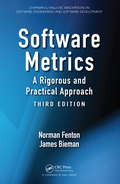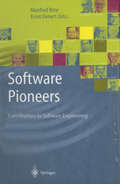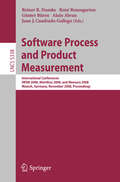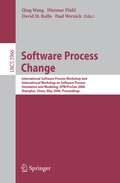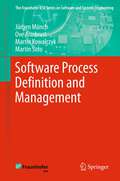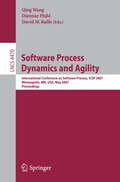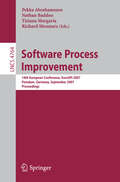- Table View
- List View
Software Methodologies: A Quantitative Guide
by Capers JonesThis comprehensive reference uses a formal and standard evaluation technique to show the strengths and weakness of more than 60 software development methodologies such as agile, DevOps, RUP, Waterfall, TSP, XP and many more. Each methodology is applied to an application of 1000 function points using the Java language. Each methodology produces a characteristic set of results for development schedules, productivity, costs, and quality. The intent of the book is to show readers the optimum kinds of methodologies for the projects they are concerned with and to warn them about counter indications and possible harm from unsuitable methodologies.
Software Metrics: A Rigorous and Practical Approach, Third Edition
by Norman Fenton James BiemanA Framework for Managing, Measuring, and Predicting Attributes of Software Development Products and ProcessesReflecting the immense progress in the development and use of software metrics in the past decades, Software Metrics: A Rigorous and Practical Approach, Third Edition provides an up-to-date, accessible, and comprehensive introduction to soft
Software Metrics: A Guide to Planning, Analysis, and Application
by C. Ravindranath PandianThe modern field of software metrics emerged from the computer modeling and "statistical thinking" services of the 1980s. As the field evolved, metrics programs were integrated with project management, and metrics grew to be a major tool in the managerial decision-making process of software companies. This book simplifies software measurement and explains its value as a tool for decision-makers at software companies. Techniques presented in Software Metrics: A Guide to Planning, Analysis, and Application are derived from best practices. The ideas are field-proven, down-to-earth, and straightforward, making it an invaluable resource for those striving for process improvement. This overview helps readers enrich their knowledge of measurements, analysis, and best practices, and demonstrates how ordinary analysis techniques can be applied to achieve extraordinary results. Easy-to-understand tools and techniques show how metrics create models that are indispensable to decision-making in the software industry.
Software Metrics: A Guide to Planning, Analysis, and Application
by C. Ravindranath PandianThe modern field of software metrics emerged from the computer modeling and "statistical thinking" services of the 1980s. As the field evolved, metrics programs were integrated with project management, and metrics grew to be a major tool in the managerial decision-making process of software companies. This book simplifies software measurement and explains its value as a tool for decision-makers at software companies. Techniques presented in Software Metrics: A Guide to Planning, Analysis, and Application are derived from best practices. The ideas are field-proven, down-to-earth, and straightforward, making it an invaluable resource for those striving for process improvement. This overview helps readers enrich their knowledge of measurements, analysis, and best practices, and demonstrates how ordinary analysis techniques can be applied to achieve extraordinary results. Easy-to-understand tools and techniques show how metrics create models that are indispensable to decision-making in the software industry.
Software Metrics and Software Metrology
by Alain AbranMost of the software measures currently proposed to the industry bring few real benefits to either software managers or developers. This book looks at the classical metrology concepts from science and engineering, using them as criteria to propose an approach to analyze the design of current software measures and then design new software measures (illustrated with the design of a software measure that has been adopted as an ISO measurement standard). The book includes several case studies analyzing strengths and weaknesses of some of the software measures most often quoted. It is meant for software quality specialists and process improvement analysts and managers.
Software Metrics and Software Metrology
by Alain AbranMost of the software measures currently proposed to the industry bring few real benefits to either software managers or developers. This book looks at the classical metrology concepts from science and engineering, using them as criteria to propose an approach to analyze the design of current software measures and then design new software measures (illustrated with the design of a software measure that has been adopted as an ISO measurement standard). The book includes several case studies analyzing strengths and weaknesses of some of the software measures most often quoted. It is meant for software quality specialists and process improvement analysts and managers.
Software-Metriken in der Praxis: Einführung und Anwendung von Software-Metriken in der industriellen Praxis
by Christof Ebert Reiner DumkeSoftware Paradigms
by Stephen H. KaislerSoftware Paradigms provides the first complete compilation of software paradigms commonly used to develop large software applications, with coverage ranging from discrete problems to full-scale applications. The book focuses on providing a structure for understanding a hierarchy of software development approaches, and showing the relationships between the different models. Coverage includes paradigms in design patterns, software components, software architectures, and frameworks. Chapters within each of these sections include design issues related to building and using the paradigm as well as numerous real world applications. A practical overview of the hierarchy of development paradigms, Software Paradigms is an excellent teaching tool for undergraduates and graduates, and a comprehensive and reliable reference for software engineers.
Software Patterns, Knowledge Maps, and Domain Analysis
by Mohamed E. FayadSoftware design patterns are known to play a vital role in enhancing the quality of software systems while reducing development time and cost. However, the use of these design patterns has also been known to introduce problems that can significantly reduce the stability, robustness, and reusability of software. This book introduces a new process fo
Software Performability: From Concepts to Applications (The Springer International Series in Engineering and Computer Science #347)
by Ann T. Tai John F. Meyer Algirdas AvizienisComputers are currently used in a variety of critical applications, including systems for nuclear reactor control, flight control (both aircraft and spacecraft), and air traffic control. Moreover, experience has shown that the dependability of such systems is particularly sensitive to that of its software components, both the system software of the embedded computers and the application software they support. Software Performability: From Concepts to Applications addresses the construction and solution of analytic performability models for critical-application software. The book includes a review of general performability concepts along with notions which are peculiar to software performability. Since fault tolerance is widely recognized as a viable means for improving the dependability of computer system (beyond what can be achieved by fault prevention), the examples considered are fault-tolerant software systems that incorporate particular methods of design diversity and fault recovery. Software Performability: From Concepts to Applications will be of direct benefit to both practitioners and researchers in the area of performance and dependability evaluation, fault-tolerant computing, and dependable systems for critical applications. For practitioners, it supplies a basis for defining combined performance-dependability criteria (in the form of objective functions) that can be used to enhance the performability (performance/dependability) of existing software designs. For those with research interests in model-based evaluation, the book provides an analytic framework and a variety of performability modeling examples in an application context of recognized importance. The material contained in this book will both stimulate future research on related topics and, for teaching purposes, serve as a reference text in courses on computer system evaluation, fault-tolerant computing, and dependable high-performance computer systems.
Software Performance and Scalability: A Quantitative Approach (Quantitative Software Engineering Series #7)
by Henry H. LiuPraise from the Reviewers: "The practicality of the subject in a real-world situation distinguishes this book from others available on the market." —Professor Behrouz Far, University of Calgary "This book could replace the computer organization texts now in use that every CS and CpE student must take. . . . It is much needed, well written, and thoughtful." —Professor Larry Bernstein, Stevens Institute of Technology A distinctive, educational text onsoftware performance and scalability This is the first book to take a quantitative approach to the subject of software performance and scalability. It brings together three unique perspectives to demonstrate how your products can be optimized and tuned for the best possible performance and scalability: The Basics—introduces the computer hardware and software architectures that predetermine the performance and scalability of a software product as well as the principles of measuring the performance and scalability of a software product Queuing Theory—helps you learn the performance laws and queuing models for interpreting the underlying physics behind software performance and scalability, supplemented with ready-to-apply techniques for improving the performance and scalability of a software system API Profiling—shows you how to design more efficient algorithms and achieve optimized performance and scalability, aided by adopting an API profiling framework (perfBasic) built on the concept of a performance map for drilling down performance root causes at the API level Software Performance and Scalability gives you a specialized skill set that will enable you to design and build performance into your products with immediate, measurable improvements. Complemented with real-world case studies, it is an indispensable resource for software developers, quality and performance assurance engineers, architects, and managers. It is anideal text for university courses related to computer and software performance evaluation and can also be used to supplement a course in computer organization or in queuing theory for upper-division and graduate computer science students.
Software Performance and Scalability: A Quantitative Approach (Quantitative Software Engineering Series #7)
by Henry H. LiuPraise from the Reviewers: "The practicality of the subject in a real-world situation distinguishes this book from others available on the market." —Professor Behrouz Far, University of Calgary "This book could replace the computer organization texts now in use that every CS and CpE student must take. . . . It is much needed, well written, and thoughtful." —Professor Larry Bernstein, Stevens Institute of Technology A distinctive, educational text onsoftware performance and scalability This is the first book to take a quantitative approach to the subject of software performance and scalability. It brings together three unique perspectives to demonstrate how your products can be optimized and tuned for the best possible performance and scalability: The Basics—introduces the computer hardware and software architectures that predetermine the performance and scalability of a software product as well as the principles of measuring the performance and scalability of a software product Queuing Theory—helps you learn the performance laws and queuing models for interpreting the underlying physics behind software performance and scalability, supplemented with ready-to-apply techniques for improving the performance and scalability of a software system API Profiling—shows you how to design more efficient algorithms and achieve optimized performance and scalability, aided by adopting an API profiling framework (perfBasic) built on the concept of a performance map for drilling down performance root causes at the API level Software Performance and Scalability gives you a specialized skill set that will enable you to design and build performance into your products with immediate, measurable improvements. Complemented with real-world case studies, it is an indispensable resource for software developers, quality and performance assurance engineers, architects, and managers. It is anideal text for university courses related to computer and software performance evaluation and can also be used to supplement a course in computer organization or in queuing theory for upper-division and graduate computer science students.
Software Pioneers: Contributions to Software Engineering
by Manfred Broy Ernst DenertA lucid statement of the philosophy of modular programming can be found in a 1970 textbook on the design of system programs by Gouthier and Pont [1, l Cfl0. 23], which we quote below: A well-defined segmentation of the project effort ensures system modularity. Each task fonos a separate, distinct program module. At implementation time each module and its inputs and outputs are well-defined, there is no confusion in the intended interface with other system modules. At checkout time the in tegrity of the module is tested independently; there are few sche duling problems in synchronizing the completion of several tasks before checkout can begin. Finally, the system is maintained in modular fashion; system errors and deficiencies can be traced to specific system modules, thus limiting the scope of detailed error searching. Usually nothing is said about the criteria to be used in dividing the system into modules. This paper will discuss that issue and, by means of examples, suggest some criteria which can be used in decomposing a system into modules. A Brief Status Report The major advancement in the area of modular programming has been the development of coding techniques and assemblers which (1) allow one modu1e to be written with little knowledge of the code in another module, and (2) alJow modules to be reas sembled and replaced without reassembly of the whole system.
Software Piracy Exposed
by Ron HonickThis book is about software piracy--what it is and how it's done. Stealing software is not to be condoned, and theft of intellectual property and copyright infringement are serious matters, but it's totally unrealistic to pretend that it doesn't happen. Software piracy has reached epidemic proportions. Many computer users know this, the software companies know this, and once you've read the Introduction to this book, you'll understand why. Seeing how widespread software piracy is, learning how it's accomplished, and particularly how incredibly easy it is to do might surprise you. This book describes how software piracy is actually being carried out. - This book is about software piracy--what it is and how it's done - This is the first book ever to describe how software is actually stolen and traded over the internet - Discusses security implications resulting from over 1/2 of the internet's computers running illegal, unpatched, pirated software
Software Process and Product Measurement: International Conferences IWSM 2009 and Mensura 2009 Amsterdam, The Netherlands, November 4-6, 2009. Proceedings (Lecture Notes in Computer Science #5891)
by René Braungarten Reiner R. Dumke Juan J. Cuadrado-Gallego Jacob Brunekreef Alain AbranThis book constitutes the refereed proceedings of two joint events - the International Workshop on Software Measurement, IWSM 2009 and the International Conference on Software Process and Product Measurement, Mensura 2009, held in Amsterdam, The Netherlands, in November 2009. The 24 revised full papers presented were carefully reviewed and selected from numerous submissions for inclusion in the book. This book considers issues such as the applicability of measures and metrics to software, the efficiency of measurement programs in industry and the theoretical foundations of software engineering.
Software Process and Product Measurement: International Conference, IWSM–MENSURA 2007, Palma de Mallorca, Spain, November 5-8, 2007, Revised Papers (Lecture Notes in Computer Science #4895)
by Reiner R. Dumke Alain Abran Juan J. Cuadrado-Gallego René BraungartenThis book constitutes the thoroughly refereed post-proceedings of the International Workshop on Software Measurement, IWSM-Mensura 2007, held in Palma de Mallorca, Spain, in November 2007. The 16 revised full papers presented were carefully reviewed and selected for inclusion in the book. The papers deal with aspects of software measurement like function-points measurement, effort and cost estimates, prediction, industrial experiences in software measurement, planning and implementing measurement, measurement-based software process improvement, best practices in software measurement, usability and user interaction measurement, measurement of open source projects, teaching and learning software measurement as well as new trends and ontologies for software measurement.
Software Process and Product Measurement: International Conferences IWSM 2008, Metrikon 2008, and Mensura 2008 Munich, Germany, November 18-19, 2008. Proceedings (Lecture Notes in Computer Science #5338)
by Reiner R. Dumke René Braungarten Günter Büren Alain Abran Juan J. Cuadrado-GallegoThis book constitutes the refereed proceedings of three joint events - the International Workshop on Software Measurement, IWSM 2008, the DASMA Metrik Kongress, Metrikon 2008, and the International Conference on Software Process and Product Measurement, Mensura 2008, held in Munich, Germany, in November 2008. The 30 revised full papers presented were carefully reviewed and selected from over 50 submissions for inclusion in the book. The papers are organized in topical sections on estimation models, measurement methodology, effort estimation, measurement programs, new approaches, prozessbewertung, size measurement, education, measurement in software lifecycle, and product measurement.
Software Process Automation: The Technology and Its Adoption
by Alan M. ChristieProcess automation provides a means to integrate people in a software development organization with the development process and the tools supporting that development. This new technology may significantly improve software quality and development productivity. However, as yet there is little practical experience in its day-to-day use. This book is for those who wish to explore the technology or are considering its adoption. The monograph discusses the underlying concepts, reviews in some detail two of the major process automation products, relates process automation to process improvement, and provides adoption guidelines. Special emphasis is on the process modeling language ProNet which is commercially available. The book is enriched by numerous examples, tables, and technical appendices.
Software Process Change: International Software Process Workshop and International Workshop on Software Process Simulation and Modeling, SPW/ProSim 2006, Shanghai, China, May 20-21, 2006, Proceedings (Lecture Notes in Computer Science #3966)
by Qing Wang Dietmar Pfahl David M. Raffo Paul WernickThis book constitutes the refereed proceedings of the First joint International Software Process Workshop and the International Workshop on Software Process Simulation and Modeling, SPW/ProSim 2006. The 34 revised full papers presented together with 4 keynote addresses are organized in topical sections on process tailoring and decision-support, process tools and metrics, process management, process representation, analysis and modeling, process simulation modeling, process simulation applications, and experience report.
Software Process Definition and Management (The Fraunhofer IESE Series on Software and Systems Engineering)
by Jürgen Münch Ove Armbrust Martin Kowalczyk Martín SotoThe concept of processes is at the heart of software and systems engineering. Software process models integrate software engineering methods and techniques and are the basis for managing large-scale software and IT projects. High product quality routinely results from high process quality.Software process management deals with getting and maintaining control over processes and their evolution. Becoming acquainted with existing software process models is not enough, though. It is important to understand how to select, define, manage, deploy, evaluate, and systematically evolve software process models so that they suitably address the problems, applications, and environments to which they are applied. Providing basic knowledge for these important tasks is the main goal of this textbook.Münch and his co-authors aim at providing knowledge that enables readers to develop useful process models that are suitable for their own purposes. They start with the basic concepts. Subsequently, existing representative process models are introduced, followed by a description of how to create individual models and the necessary means for doing so (i.e., notations and tools). Lastly, different possible usage scenarios for process management are highlighted (e.g. process improvement and software process simulation).Their book is aimed at students and researchers working on software project management, software quality assurance, and software measurement; and at practitioners who are interested in process definition and management for developing, maintaining, and operating software-intensive systems and services.
Software Process Dynamics
by Raymond J. MadachyThis book is designed for professionals and students in software engineering or information technology who are interested in understanding the dynamics of software development in order to assess and optimize their own process strategies. It explains how simulation of interrelated technical and social factors can provide a means for organizations to vastly improve their processes. It is structured for readers to approach the subject from different perspectives, and includes descriptive summaries of the best research and applications.
Software Process Dynamics and Agility: International Conference on Software Process, ICSP 2007, Minneapolis, MN, USA, May 19-20, 2007, Proceedings (Lecture Notes in Computer Science #4470)
by Qing Wang Dietmar Pfahl David M. RaffoThis book constitutes the refereed proceedings of the First International Conference on Software Process, held in Minneapolis, MN, USA, in May 2007. The 28 revised full papers presented together with the abstracts of two keynote addresses cover process content, process tools and metrics, process management, process representation, analysis and modeling, experience report, and simulation modeling.
Software Process Improvement: 14th European Conference, EuroSPI 2007, Potsdam, Germany, September 26-28, 2007, Proceedings (Lecture Notes in Computer Science #4764)
by Pekka Abrahamsson Nathan Baddoo Tiziana Margaria Richard MessnarzThis book constitutes the refereed proceeding of the 14th European Software Process Improvement Conference, EuroSPI 2007, held in Potsdam, Germany, in September 2007. The papers are organized in topical sections on enforcement, alignment, tailoring. There is focus on SME issues, improvement analysis and empirical studies, new avenues of SPI, SPI methodologies, as well as testing and reliability.
Software Process Improvement: 11th European Conference, EuroSPI 2004, Trondheim, Norway, November 10-12, 2004. Proceedings (Lecture Notes in Computer Science #3281)
by T. DingsøyrSoftware Process Improvement: Software Best Practice 4
by LarsBergman Eric W. Olsen MichaelHaugC. Amting Directorate General Information Society, European Commission, Brussels Under the 4th Framework of European Research, the European Systems and Soft ware Initiative (ESSI) was part of the ESPRIT Programme. This initiative funded more than 470 projects in the area' of software and system process improvements. The majority of these projects were process improvement experiments carrying out and taking up new development processes, methods and technology within the software development process of a company. In addition, nodes (centres of exper tise), European networks (organisations managing local activities), training and dissemination actions complemented the process improvement experiments. ESSI aimed at improving the software development capabilities of European enterprises. It focused on best practice and helped European companies to develop world class skills and associated technologies to build the increasingly complex and varied systems needed to compete in the marketplace. The dissemination activities were designed to build a forum, at European level, to exchange information and knowledge gained within process improvement ex periments. Their major objective was to spread the message and the results of experiments to a wider audience, through a variety of different channels. The European Experience Exchange ~UR~X) project has been one of these dis semination activities within the European Systems and Software Initiative.~UR~X has collected the results of practitioner reports from numerous workshops in Europe and presents, in this series of books, the results of Best Practice achieve ments in European Companies over the last few years.

